
Elements Of Electromagnetics
7th Edition
ISBN: 9780190698614
Author: Sadiku, Matthew N. O.
Publisher: Oxford University Press
expand_more
expand_more
format_list_bulleted
Concept explainers
Question

Transcribed Image Text:(2)
A composite member is made of a hollow brass cylinder (E = 105 GPa, v= 0.32, and a = 20.0x10/°C)
interference fit over ASTM-A242 solid steel rod (E = 200 GPa, v= 0.3, and a = 11.7x10/C). The outer
radius of brass is 100 mm, the inner radius is 50 mm, and the outer radius of steel is 50.05 mm. The length
of both is the same (This implies NO STRESS CONCENTRATION FACTOR involved).
Compute (a) the total radial interference of the brass and (b) the temperature difference AT required to
easily slip the brass cylinder over the steel rod. For easy insertion, allow a clearance of ½&, see slide 16
of Lecture 9 notes. (Hint: First calculate total interference (8 + ½8), then use definition of a (defined in
Lecture 6, slide 26).
(c) Compute the interface pressure p of the interference fit at room temperature (use the actual radial
interference for this; that is, without clearance).
%3D
Fig. 2
Expert Solution
This question has been solved!
Explore an expertly crafted, step-by-step solution for a thorough understanding of key concepts.
This is a popular solution
Trending nowThis is a popular solution!
Step by stepSolved in 2 steps with 2 images

Knowledge Booster
Learn more about
Need a deep-dive on the concept behind this application? Look no further. Learn more about this topic, mechanical-engineering and related others by exploring similar questions and additional content below.Similar questions
- I got wrong answer last time I posted. Please do it correctly.arrow_forward2. 1.5 m 3 m 400N 200 N 1 m Member AB is supported by a cable BC and at A by a square rod which fits loosely through the square hole in the collar fixed to the member as shown. Which of the following is closest to the force in cable BC?arrow_forwardAssuming a welded rail line, 1km long, that is unconstrained except at the ends. The rail has a cross sectional profile as given. If the rail was installed at a temperature of 20°C, at what temperature would the rail buckle? How much pre-stress would need to be applied to the rail in order to prevent buckling up to a maximum operating temperature of 40°C? Rail profile 46E1 Equivalent profile name SBBI Section weight kg/m 46.17 Rail height mm (H) 145.00 X Y Y Head width mm (C) 65.00 A H Web thickness mm (A) 14.00 Foot width mm (P) 125.00 Moment of inertia, Ixx cm* 1641.10 Moment of inertia, lyy cm* 298.20arrow_forward
- Question IV The forces F1 F 2, and F3 all of which act on point A of the bracket , are specified in three different ways. Determine the x and y scalar components of each of the three forces and their resultant. F 500 N F=600 N 35 0.1 m 0.2 m 03 m P= 800 N 0.4 marrow_forwardA 30-mm thick AISI 1020 steel plate is sandwiched between two 10-mm thick 2024-T3 aluminum plates and compressed with a bolt and nut with no washers. The bolt is M10 x 1.5. property class 5.8. (a) Determine a suitable length for the bolt, rounded up to the nearest 5 mm. (b) Determine the bolt stiffness. (c) Determine the stiffness of the members.arrow_forward(2) h Q11 what the value of P Which are safer on the rivets as shown in figure below. given that : T=100.34 MPa, ob=370.3 MPa, 19mm diameter of .rivets 12.5m 19mm 12.5m 250mm P.arrow_forward
- i need the answer quicklyarrow_forwardPlease solve it asap !! Strictly don't use Artificial intelligence tools.arrow_forwardA circular cross-sectional rod made of AISI Type 303 Stainless Steel is normally operated at126oF. Length and radius of the rod are 1.5 ft and 1.75 in., respectively. What would be thechange in length of the rod, if it is subjected to a temperature of 214oF? Coefficient of thermal expansion of the rods’ material is 9.6 × 10^-6 in./in. Degrees Fahrenheit.arrow_forward
arrow_back_ios
arrow_forward_ios
Recommended textbooks for you
 Elements Of ElectromagneticsMechanical EngineeringISBN:9780190698614Author:Sadiku, Matthew N. O.Publisher:Oxford University Press
Elements Of ElectromagneticsMechanical EngineeringISBN:9780190698614Author:Sadiku, Matthew N. O.Publisher:Oxford University Press Mechanics of Materials (10th Edition)Mechanical EngineeringISBN:9780134319650Author:Russell C. HibbelerPublisher:PEARSON
Mechanics of Materials (10th Edition)Mechanical EngineeringISBN:9780134319650Author:Russell C. HibbelerPublisher:PEARSON Thermodynamics: An Engineering ApproachMechanical EngineeringISBN:9781259822674Author:Yunus A. Cengel Dr., Michael A. BolesPublisher:McGraw-Hill Education
Thermodynamics: An Engineering ApproachMechanical EngineeringISBN:9781259822674Author:Yunus A. Cengel Dr., Michael A. BolesPublisher:McGraw-Hill Education Control Systems EngineeringMechanical EngineeringISBN:9781118170519Author:Norman S. NisePublisher:WILEY
Control Systems EngineeringMechanical EngineeringISBN:9781118170519Author:Norman S. NisePublisher:WILEY Mechanics of Materials (MindTap Course List)Mechanical EngineeringISBN:9781337093347Author:Barry J. Goodno, James M. GerePublisher:Cengage Learning
Mechanics of Materials (MindTap Course List)Mechanical EngineeringISBN:9781337093347Author:Barry J. Goodno, James M. GerePublisher:Cengage Learning Engineering Mechanics: StaticsMechanical EngineeringISBN:9781118807330Author:James L. Meriam, L. G. Kraige, J. N. BoltonPublisher:WILEY
Engineering Mechanics: StaticsMechanical EngineeringISBN:9781118807330Author:James L. Meriam, L. G. Kraige, J. N. BoltonPublisher:WILEY

Elements Of Electromagnetics
Mechanical Engineering
ISBN:9780190698614
Author:Sadiku, Matthew N. O.
Publisher:Oxford University Press

Mechanics of Materials (10th Edition)
Mechanical Engineering
ISBN:9780134319650
Author:Russell C. Hibbeler
Publisher:PEARSON

Thermodynamics: An Engineering Approach
Mechanical Engineering
ISBN:9781259822674
Author:Yunus A. Cengel Dr., Michael A. Boles
Publisher:McGraw-Hill Education

Control Systems Engineering
Mechanical Engineering
ISBN:9781118170519
Author:Norman S. Nise
Publisher:WILEY

Mechanics of Materials (MindTap Course List)
Mechanical Engineering
ISBN:9781337093347
Author:Barry J. Goodno, James M. Gere
Publisher:Cengage Learning

Engineering Mechanics: Statics
Mechanical Engineering
ISBN:9781118807330
Author:James L. Meriam, L. G. Kraige, J. N. Bolton
Publisher:WILEY